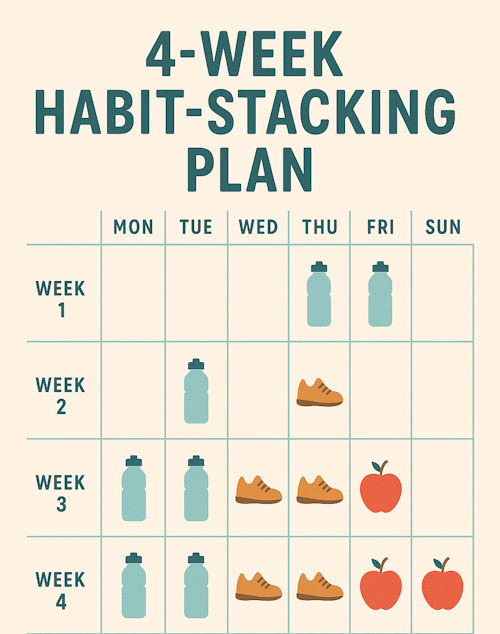Every weight loss journey begins with a spark of motivation. It’s a powerful, exhilarating feeling that makes you believe anything is possible. You clean out the pantry, buy new workout clothes, and promise yourself that this time will be different. But what happens when that initial spark fades? When a stressful day, a sleepless night, or a tempting office doughnut leaves you feeling depleted, motivation can feel like a distant memory.
This is the fundamental flaw in relying on motivation alone: it’s an emotion, and like all emotions, it’s fleeting. True, lasting change isn’t built on the shifting sands of how you feel on any given day. It’s built on the solid rock of habits—the small, automatic actions you take consistently, whether you’re feeling inspired or not.
The science of habit formation shows that our brains are wired to be efficient. When we repeat an action in the same context, our brain builds strong neural pathways that make the behavior automatic, requiring less conscious effort over time. Research consistently shows that weight loss programs focused on building these automatic habits are more successful in the long run.
One of the most effective, evidence-based methods for building these new routines is called “habit stacking.”
What is Habit Stacking?
Habit stacking is a simple but powerful technique that involves linking a new, desired behavior to an existing, deeply ingrained habit. The existing habit acts as a powerful trigger, or cue, for the new one, making it far more likely that you’ll remember and perform it.
The formula is simple:
After/Before [Current Habit], I will [New Habit].
For example, a common non-weight-loss habit stack is: “After I brush my teeth, I will floss one tooth.” Brushing your teeth is the established anchor, making the new habit of flossing much easier to adopt.
This 4-week plan uses the principle of habit stacking to introduce small, powerful changes that build on each other, creating a foundation for sustainable weight loss without overwhelming your willpower.
Your 4-Week Habit-Stacking Plan
The key to this plan is to start small and focus on consistency over intensity. Each week, you will “stack” a new habit onto an existing part of your daily routine.
Week 1: The Foundation — Hydration
- The Stack: After I brush my teeth in the morning, I will drink a full glass of water.
- Why It Works: Brushing your teeth is a non-negotiable morning ritual. By linking it to drinking water, you start your day hydrated, which helps support your metabolism and control your appetite. This is a simple, low-effort “win” that builds immediate momentum.
Week 2: Stack on Movement
- The Stack: After I finish my dinner, I will immediately put on my shoes and go for a 10-minute walk.
- Why It Works: Finishing your evening meal is a reliable daily cue. A short, brisk walk aids digestion, improves blood sugar control, and has been shown to effectively curb cravings for sweets and prevent mindless late-night snacking. A 10-minute commitment is far less intimidating than a 60-minute gym session, making it easier to do consistently.
Week 3: Stack on Mindful Planning
- The Stack: While my morning coffee is brewing, I will spend five minutes planning my healthy meals for the day.
- Why It Works: Your morning coffee is a powerful, often cherished, routine. Using that time to quickly jot down a plan for lunch, dinner, and snacks drastically reduces decision fatigue later in the day. This simple act of planning is one of the most effective strategies for avoiding impulsive, unhealthy food choices when you’re hungry and stressed.
Week 4: Stack on Smart Preparation
- The Stack: After I sit down to watch my favorite TV show in the evening, I will spend the first commercial break chopping vegetables for the next day’s lunch.
- Why It Works: This “double-duty” stack links a pleasurable activity (watching TV) with a productive one. Having pre-chopped veggies ready to go makes it infinitely easier to throw together a quick salad or stir-fry, minimizing the temptation to order takeout when you’re tired and short on time.
How to Make Your New Habits Stick
- Be Incredibly Specific: A vague plan like “I will walk more” is doomed to fail. A specific plan—”After I place my dinner plate in the dishwasher, I will walk around the block”—gives your brain a clear instruction.
- Start Ridiculously Small: If a 10-minute walk feels like too much, start with a 2-minute walk. The goal is to make the action so easy that you can’t say no. Consistency is more important than intensity in the beginning.
- Track Your Progress: Use a simple calendar or journal to put a checkmark next to each day you complete your new habit. This self-monitoring provides positive reinforcement and a sense of accomplishment.
- Be Patient: The popular myth that it takes 21 days to form a habit is not based on evidence. Scientific studies show it can take anywhere from two months to nearly a year for a new behavior to become truly automatic. If you miss a day, don’t give up. Just get back on track the next day.
Building unbreakable motivation has nothing to do with finding a secret reserve of willpower. It’s about building a smarter system. By strategically stacking small, consistent habits, you create an automated routine that works for you, leading to significant and, most importantly, sustainable results.




